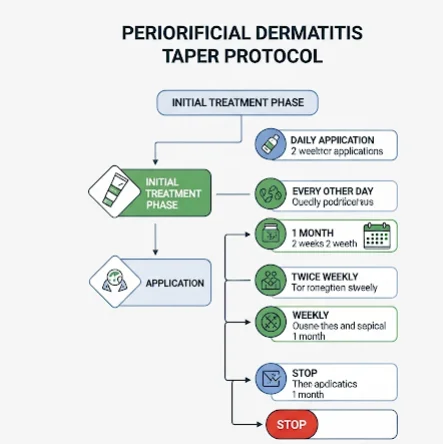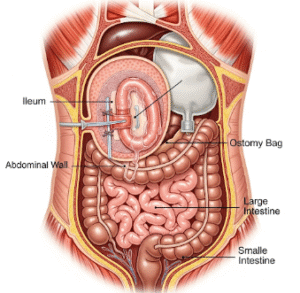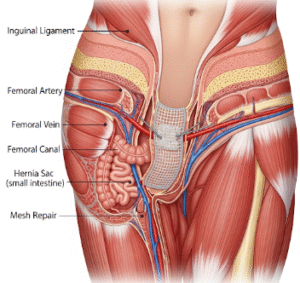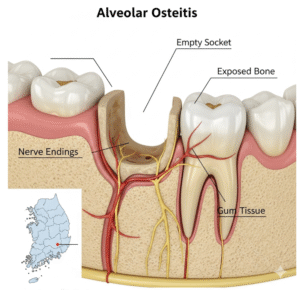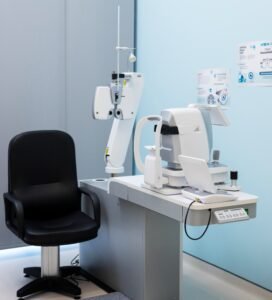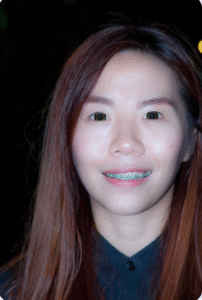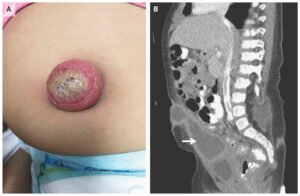What it is
➝ Periorificial dermatitis (also called perioral dermatitis when it appears around the mouth) is an inflammatory skin condition that causes small red papules, pustules, and scaling around the mouth, nose, and eyes.
➝ It is commonly triggered or worsened by topical corticosteroid use, heavy cosmetics, or fluoridated toothpaste.
➝ A taper protocol is required when patients have been using topical steroids, because sudden withdrawal can worsen flares. The tapering approach allows the skin to adjust while gradually restoring barrier function.
➝ In Korea, dermatologists combine stepwise steroid tapering, transition therapies, and skin barrier support to manage periorificial dermatitis effectively.
Why it’s done
→ To avoid steroid withdrawal flares, which can cause worsening redness, itching, and burning.
→ To safely wean patients off corticosteroids while transitioning them to non-steroidal treatments.
→ To achieve long-term remission without dependency on steroids.
→ To reduce patient distress, as periorificial dermatitis often affects cosmetically sensitive areas of the face.
→ In Korea, the taper protocol is carefully individualized, emphasizing skin barrier care and patient education.
Alternatives
→ Immediate steroid discontinuation (in mild cases), though this may cause a temporary flare.
→ Non-steroidal treatments:
- Topical calcineurin inhibitors (tacrolimus, pimecrolimus).
- Topical metronidazole, azelaic acid, or ivermectin.
- Oral antibiotics (low-dose doxycycline, tetracycline, or minocycline) for resistant or widespread disease.
→ Lifestyle changes:
- Avoid heavy cosmetics, occlusive skincare, and harsh cleansers.
- Switch to gentle, fragrance-free skincare products.
- Avoid topical steroids on the face unless absolutely necessary.
Preparation
→ Dermatologist confirms diagnosis and rules out similar conditions (rosacea, seborrheic dermatitis, acne).
→ Patient education is essential before tapering:
- Explaining that symptoms may temporarily worsen during withdrawal.
- Stressing the importance of skincare simplification.
- Discussing supportive therapies (oral or topical).
→ Korean clinics often prepare patients with written skincare routines and provide sample soothing products for the transition period.
How it’s Done
→ Step 1: Gradual reduction of topical steroids
- Switch from potent to lower-potency steroids.
- Reduce application frequency (e.g., daily → every other day → twice weekly).
- Apply only to active lesions, not entire areas.
→ Step 2: Introduction of non-steroidal agents
- Start topical calcineurin inhibitors (tacrolimus, pimecrolimus) in place of steroids.
- Introduce soothing agents (niacinamide, hyaluronic acid, barrier creams).
→ Step 3: Add targeted therapies
- Topical metronidazole, azelaic acid, or ivermectin for inflammation.
- Oral doxycycline (low-dose) in moderate-to-severe cases.
→ Step 4: Skincare simplification
- Use mild, fragrance-free cleansers and non-comedogenic moisturizers.
- Strict sun protection with non-irritating mineral sunscreens.
→ Step 5: Long-term prevention
- Avoid future steroid use on the face.
- Maintain barrier function with consistent skincare.
→ In Korea, dermatologists often combine Western medical protocols with advanced K-beauty skincare strategies to speed recovery.
Recovery
→ First 1–2 weeks: Temporary flare or rebound may occur after taper initiation.
→ Weeks 3–6: Gradual improvement, with fewer papules and reduced redness.
→ After 8–12 weeks: Clear or near-clear skin in most patients if the protocol is followed.
→ Patients typically experience improved comfort, appearance, and skin confidence once the dermatitis resolves.
→ Maintenance with non-steroidal skincare and avoidance of triggers helps prevent recurrence.
Complications
→ Steroid withdrawal flare: Initial worsening with increased redness, burning, and bumps.
→ Persistent dermatitis if tapering is too fast or supportive treatments are not added.
→ Relapse if patients return to steroid use on the face.
→ Psychological distress, since the flare occurs in visible areas (mouth, nose, eyes).
→ With proper guidance and support, these complications are temporary and manageable.
Treatment Options in Korea
→ Korean dermatology clinics use structured tapering protocols with close follow-up visits to monitor progress.
→ Patients are often given dual prescriptions: a weaker steroid for tapering and a calcineurin inhibitor for long-term control.
→ Many clinics recommend barrier-restoring moisturizers from Korean cosmeceutical brands, which are formulated for sensitive skin.
→ Dermatologists in Korea also integrate laser treatments (e.g., vascular lasers like PDL or IPL) if redness persists after inflammation subsides.
→ Patient education is a strong focus: Korean doctors emphasize daily routines, skincare product choices, and long-term prevention strategies.
→ This structured and supportive approach makes Korea a leader in comprehensive periorificial dermatitis management, balancing taper safety with modern skincare science.

